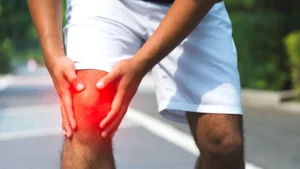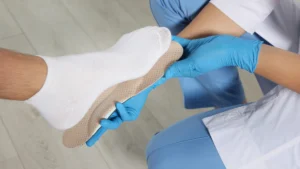Flat feet isn’t a life sentence.
Pes Planus—better known as flat feet—can mess with your posture, cause chronic pain, and trigger joint issues if left unchecked. But the fix doesn’t have to be complicated. With the right strategy, you can rebuild strength, support your arches, and take the pressure off. In this post, we’ll break down 5 practical steps to help you strengthen your feet, improve balance, and move with confidence again.
The Anatomy of Pes Planus: What Lies Beneath
Your flat feet result from a variety of structural components working (or not working) together. Understanding these elements gives you insight into how pes planus affects your overall foot function. The primary issue lies in the arches, which can either be absent or too low, leading to an alteration in your foot’s biomechanics. As a result, the way weight is distributed across your foot changes, influencing how you walk, run, and even stand throughout the day.
The Structural Components of Flat Feet
Flat feet are defined by the collapse of the medial longitudinal arch—the curved inner part of your foot that normally helps absorb shock and support movement. In people with flat feet, this arch is either underdeveloped or has collapsed entirely, causing the entire sole to make contact with the ground when standing or walking.
Structurally, this affects more than just the foot. It causes the ankles to roll inward (overpronation), shifts joint alignment, and places abnormal stress on the knees, hips, and lower back. What starts in the foot quickly becomes a full-body issue.
Common symptoms include aching feet, especially after long periods of standing or walking, pain in the arch or heel, and swelling near the inner ankle. Balance may be affected, and standing on tiptoes can become difficult.
If ignored, flat feet can lead to a range of related foot conditions, such as plantar fasciitis, posterior tibial tendon dysfunction, shin splints, and even chronic joint pain in the knees and back. Addressing the root structure—through supportive footwear and strengthening—can restore function and prevent long-term damage.
Unveiling the Root Causes: Why Your Feet Are Flat
Flat feet, or Pes Planus, can stem from a variety of underlying factors that contribute to this condition. Understanding the origins of flat feet can help you take the necessary steps to manage or even correct this issue. From genetic predispositions to lifestyle choices, exploring these root causes is crucial for strengthening your feet and overall foot health.
Genetic Factors and Predispositions
Genetics play a significant role in determining the structure of your feet. If you have a family history of flat feet, it’s likely that you might experience the same condition. Inheriting certain traits, such as weak tendons or ligaments, can predispose you to flat arches. Other genetic issues can include the shape of the heel bone or how your foot functions during walking and standing.
- You may have inherited a tendency for flat feet.
- Structural abnormalities can be passed down through generations.
- Joint flexibility can indicate a genetic predisposition.
This genetic component means that for some individuals, flat feet might be an inherited characteristic rather than solely the result of lifestyle choices.
Lifestyle Choices That Lead to Flat Feet
Your daily habits significantly influence your foot health. Over time, wearing unsupportive shoes, engaging in excessive standing or walking without adequate arch support, and neglecting foot exercises can contribute to flat feet. Additionally, being overweight can exert additional pressure on your arches, leading to their gradual collapse. Prioritizing foot health in your lifestyle choices can mitigate the risk of developing flat feet.
Choosing inappropriate footwear is another common mistake that can lead to flat feet. Many people opt for stylish shoes that lack arch support, ultimately affecting foot structure and function. While high heels may look appealing, they shift your body weight forward, exacerbating arch issues. If you’re engaged in sports or activities, wearing the wrong kind of shoes can also be detrimental. Moreover, a sedentary lifestyle can lead to weakened foot muscles and ligaments, increasing your risk for flat feet. Prioritizing supportive footwear and maintaining a balanced lifestyle can significantly improve your foot’s structure and overall health.
Strengthening Your Foundation: Practical Techniques
Addressing flat feet requires targeted strategies to enhance the strength of your foot structures. Implementing practical techniques will not only fortify your arches but also improve overall foot health, allowing you to engage comfortably in daily activities. Effective exercises and routines tailored to your specific needs can lead to noticeable improvements in strength and flexibility, helping you achieve a more stable foundation for your movements.
Targeted Exercises for Foot Strength
Incorporate exercises like toe curls, arch lifts, and calf raises into your routine to specifically target and strengthen the muscles of your feet. Performing these exercises regularly will not only enhance the support for your arches but also promote better balance and stability while walking and running. Start with three sets of 10-15 repetitions, focusing on proper form to maximize the benefits.
Recommended Stretching and Flexibility Routines
Integrating stretching routines is crucial for maintaining foot flexibility, which complements strengthening exercises. Stretches such as the seated toe stretch and Achilles tendon stretch help alleviate tightness in the foot and calf muscles, providing relief and improving overall function. Aim to hold each stretch for 15-30 seconds and repeat them three times per session.
Working on stretching regularly helps counteract the tension built up in the muscles and connective tissue around your feet. Enhanced flexibility not only improves your range of motion but also aids in reducing discomfort associated with flat feet. Targeted flexibility routines will have a profound impact on your overall foot health, leading to better functionality in your daily life, from standing to walking and running.
The Impact of Footwear: Choosing the Right Shoes
Your choice of footwear plays a significant role in managing pes planus and enhancing comfort. Shoes that lack adequate support can exacerbate the symptoms of flat feet, making even everyday activities more challenging. Understanding what to look for in footwear can help you make informed decisions that promote foot health and overall well-being.
Features of Supportive Footwear
Supportive footwear typically includes elements such as arch support, cushioning, a firm heel counter, and a wide toe box. Look for shoes with built-in insoles that contour to the shape of your foot and help distribute pressure evenly. Additionally, the outsole should provide good traction and stability to minimize the risk of slips and falls.
Avoiding Common Pitfalls in Shoe Selection
When deciding on shoes, avoiding common pitfalls can make a vast difference in your foot comfort. Many people gravitate towards stylish options without considering functionality or support. Prioritize shoes that encourage healthy foot mechanics over current trends. Be vigilant about trying on shoes later in the day, as feet tend to swell, ensuring a better fit, and always check for adequate arch support that matches your specific foot structure.
Many individuals overlook the importance of proper sizing, thinking that a snug fit is best for support. However, tight shoes can actually cause more harm than good, leading to blisters and discomfort. Always opt for shoes that allow your toes some wiggle room, and don’t hesitate to seek out specialty shops that focus on providing quality, supportive footwear tailored for flat feet. Conversely, substituting worn-out shoes too late can hinder your foot health. Set a schedule to evaluate your footwear regularly, and replace them at the first signs of wear and tear to maintain optimal support and comfort.
Beyond the Foot: The Link Between Flat Feet and Overall Health
Your flat feet may seem like a localized issue, but the implications extend far beyond your soles. Pes planus can impact alignment throughout your body, affecting how you stand, walk, and move daily. This misalignment can lead to discomfort in your knees, hips, and even your back, creating a ripple effect that influences your overall health. Addressing flat feet early on might not only alleviate foot pain but can also contribute significantly to your well-being and functional mobility.
Potential Long-term Health Consequences
Living with pes planus for an extended period can lead to complex health issues that extend beyond foot pain. Over time, misalignment can contribute to conditions such as tendonitis, arthritis, and even chronic back pain. The continuous strain on kinetic chain refers to how various body parts work together, which may exacerbate existing issues or create new ones if not properly addressed.
Long-term effects of pes planus often manifest in unexpected ways. For example, you may develop tendinitis in the Achilles tendon due to the constant strain and altered mechanics. Those with flat feet are also at a higher risk for joint issues since imbalance can lead to overuse injuries in the knees and hips. Moreover, studies show that individuals with flat feet are prone to lower back pain—a connection that highlights the importance of proper foot care. It’s crucial to recognize that your flat feet can have far-reaching implications, making early intervention vital for maintaining your overall health.
Putting Pes Planus in Its Place: Your Path to Stronger, Healthier Feet
Flat feet aren’t just a cosmetic issue—they’re a structural imbalance that affects your entire body from the ground up. If left untreated, they can trigger a domino effect of pain and dysfunction, from heel aches to chronic knee and back problems. But with the right support and a targeted strengthening plan, you can restore balance, reduce discomfort, and move confidently again.
At Custom Orthopedic Solutions in Edmonton, we specialize in helping clients manage conditions like Pes Planus through custom orthotics, footwear solutions, and expert guidance. Ready to fix your foundation? Book your consultation today and take the first step toward stronger, pain-free feet.





